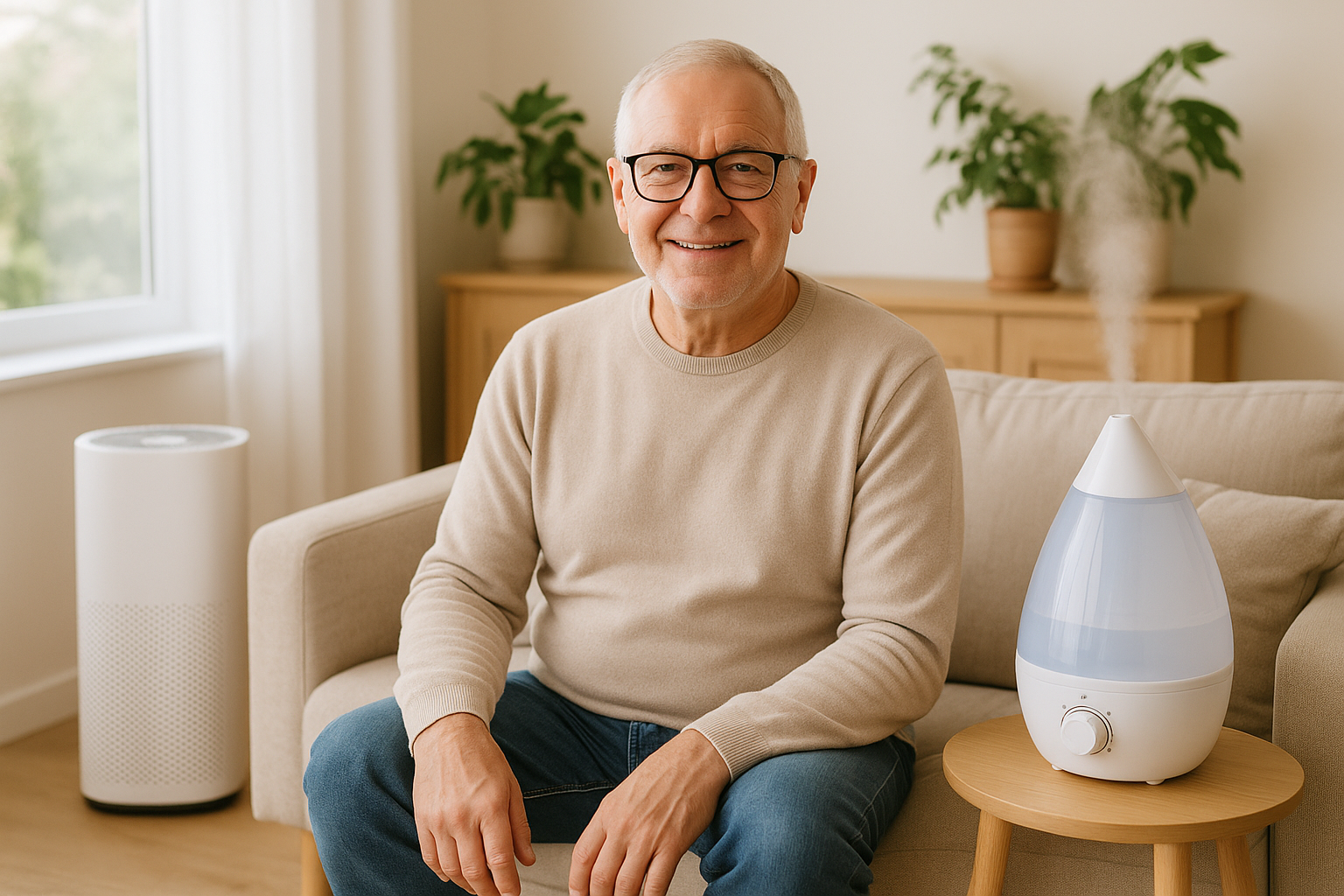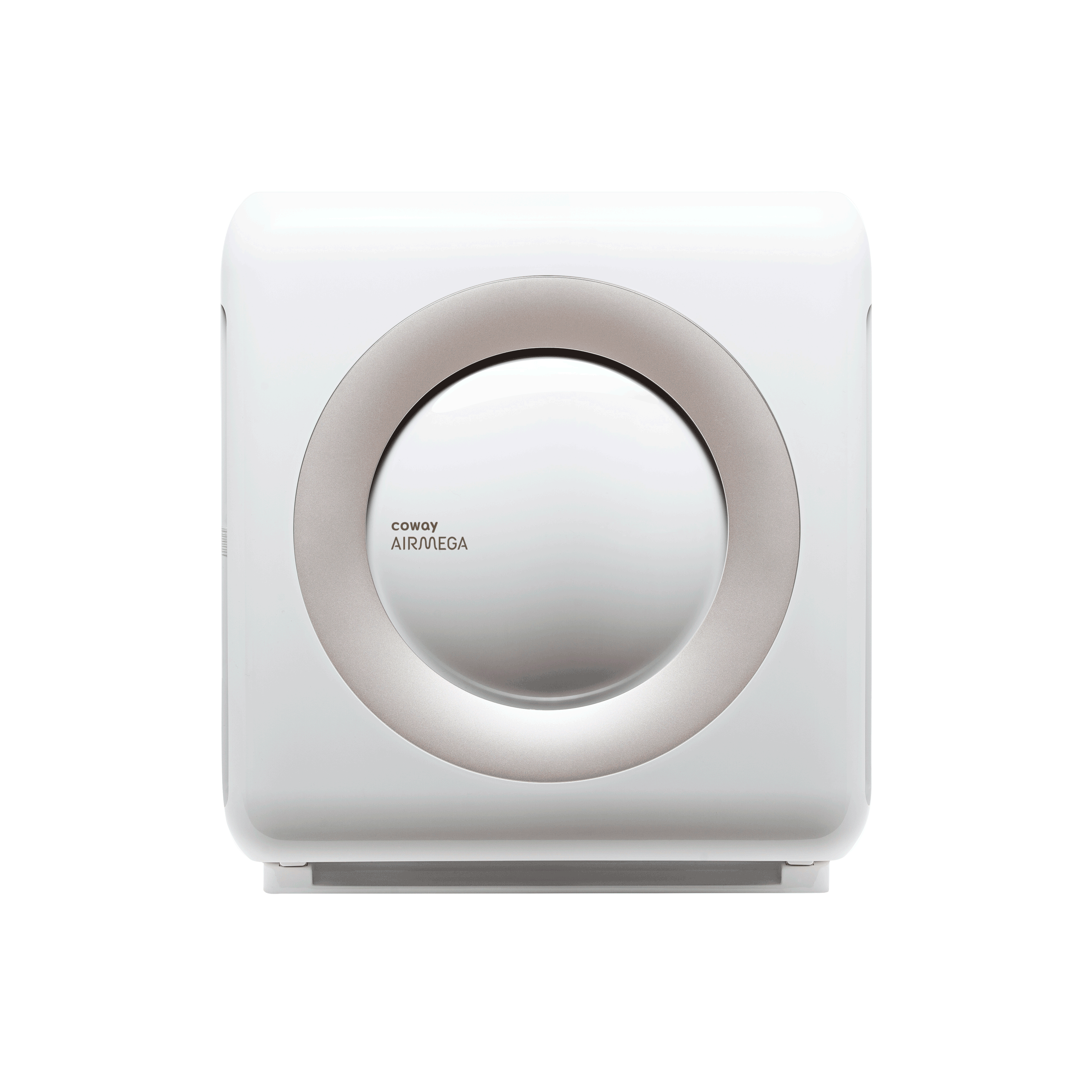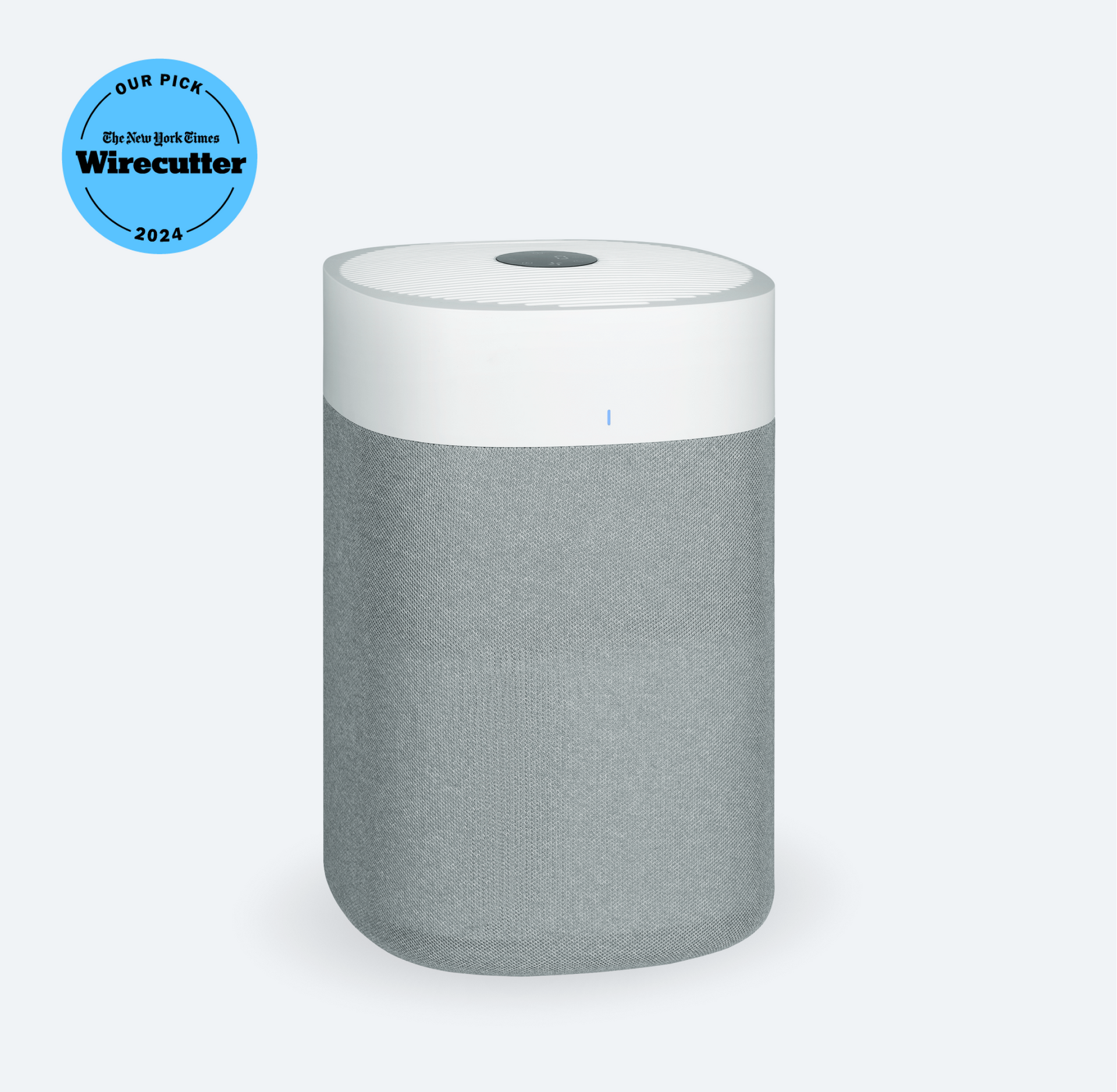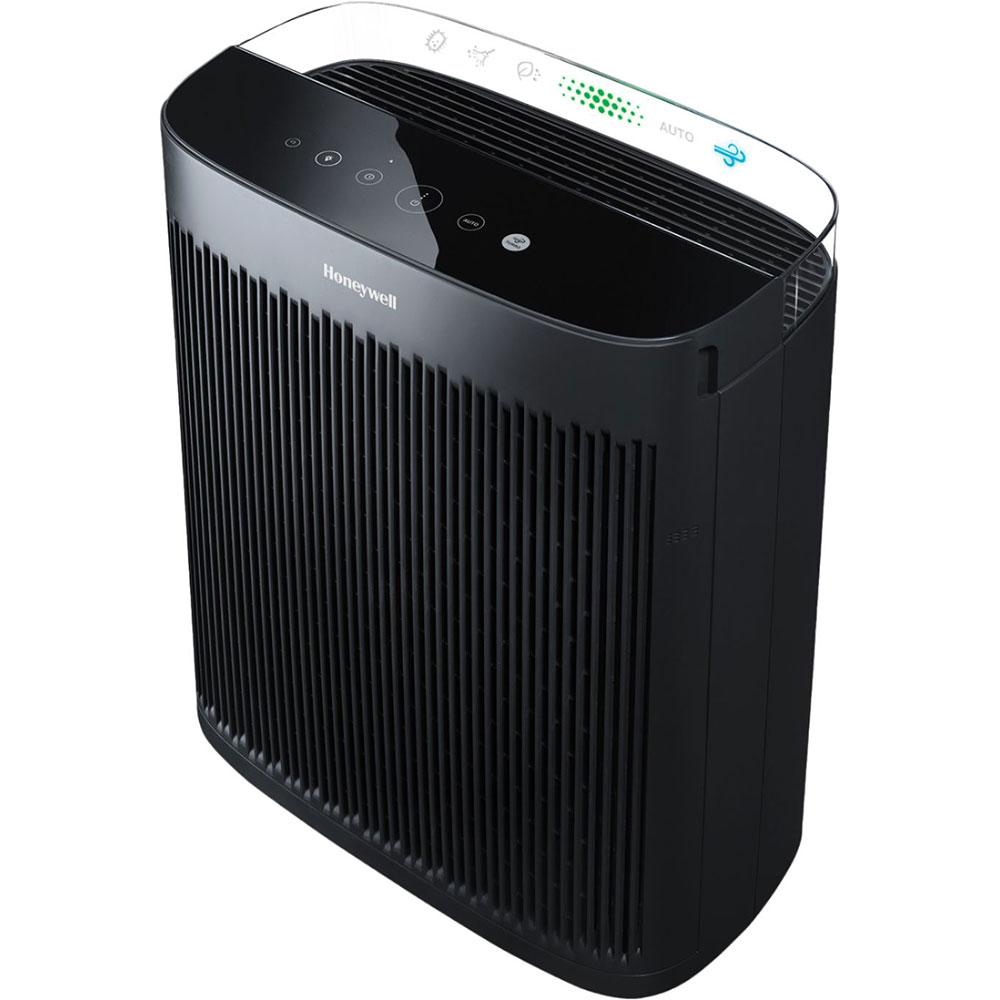Air Purifier vs Humidifier for COPD: Which Do You Need in 2025?
Last updated: September 2025 | Medically reviewed by respiratory therapy professionals
Disclosure: We may earn a commission when you purchase through our links, at no additional cost to you. This helps us provide free, evidence-based content to help you manage your COPD.
If you're managing COPD, choosing between an air purifier and a humidifier - or using both - depends on your specific needs. Here's the quick breakdown:
Our Top Picks (September 2025)
Best Air Purifier: Coway Airmega Mighty AP-1512HH - 4-stage filtration with real-time air quality indicator View Full Review →
Best Large Room Purifier: Honeywell HPA5300B - True HEPA filtration for spaces up to 465 sq ft View Full Review →
Best Smart Humidifier: LEVOIT Classic 300S - Smart app control with precise humidity monitoring View Full Review →
- Air purifiers clean the air by removing pollutants like dust, smoke, and pet dander. Ideal for reducing triggers that worsen COPD symptoms.
- Humidifiers add moisture to dry air, easing coughing, thinning mucus, and reducing throat irritation. Best for combating dryness, especially in winter.
- Using both can address multiple issues, but they must be placed separately to work effectively.
Key Considerations:
- Use an air purifier if pollutants like smoke or allergens are your main concern.
- Opt for a humidifier if dry air worsens your symptoms.
- Maintain indoor humidity at 30-50% for optimal comfort.
- Regular maintenance is crucial for both devices to function properly.
Quick Comparison:
| Feature | Air Purifier | Humidifier |
|---|---|---|
| Primary Function | Removes pollutants and allergens | Adds moisture to dry air |
| COPD Benefits | Reduces flare-ups from irritants | Eases dry cough and thick mucus |
| Ideal For | Smoke, pet dander, dust, odors | Winter dryness, throat comfort |
| Key Limitation | Doesn't address dryness | Doesn't remove pollutants |
| Maintenance | Filter replacement (3-6 months) | Daily cleaning, weekly deep clean |
Air Purifiers Vs. Humidifiers: What's Best for You?
What Each Device Does: Functions and Limits
Understanding how these devices work can help you choose the right one to support your breathing needs.
Air Purifiers: Clearing the Air of Pollutants
Air purifiers are designed to remove airborne pollutants using HEPA filters, which capture 99.97% of particles as small as 0.3 microns, and activated carbon filters that absorb odors and gases. These filters trap dust, pollen, pet dander, and smoke, while also neutralizing smells from cooking, chemical fumes, and volatile organic compounds (VOCs).
The main benefit? Cleaner air. By reducing airborne irritants, air purifiers can create a more comfortable environment, especially in spaces like bedrooms, where cleaner air can help reduce COPD flare-ups caused by pollutants.
That said, air purifiers have their limits. They don't add moisture to the air, so they can't address issues like dryness-related mucus thickening. Plus, they can't remove particles that have already settled on surfaces. Regular filter replacements, typically every 3-6 months, are also an ongoing expense to consider.
While air purifiers focus on airborne pollutants, humidifiers tackle dryness - a different but equally important factor in managing COPD symptoms.
Humidifiers: Adding Moisture for Relief in Dry Air
Humidifiers work by increasing the water vapor in indoor air, offering relief from symptoms caused by dryness. When humidity levels dip below 30%, your nasal passages and throat can become irritated, leading to more coughing and making it harder to clear mucus.
Devices like ultrasonic and evaporative humidifiers release a fine mist that helps keep airways moist, reducing irritation from dry air. Maintaining indoor humidity between 30-50% can ease morning coughs, reduce throat discomfort, and make breathing more comfortable, especially during colder months.
However, humidifiers come with their own challenges. They don't filter out pollutants, so dust, smoke, and allergens remain in the air. Over-humidifying (above 50%) can create conditions for mold and dust mites to thrive, potentially worsening symptoms. Regular cleaning of the water tank and internal parts is essential to prevent bacteria and mold buildup.
Air Purifiers vs. Humidifiers: A Quick Comparison
| Feature | Air Purifier | Humidifier |
|---|---|---|
| Primary Function | Removes particles, allergens, smoke, and odors | Adds moisture to dry indoor air |
| COPD Benefits | Reduces airborne triggers, fewer pollutant-related flare-ups | Eases dry cough, thins mucus, reduces throat irritation |
| Ideal For | Smoke exposure, pet allergies, dust sensitivity, odor control | Winter dryness, thick mucus, morning cough, throat scratchiness |
| Key Limitations | Doesn't address dry air, ongoing filter costs | Doesn't remove pollutants, mold risk if not maintained |
| Maintenance | Filter replacement every 3-6 months | Daily water changes, weekly cleaning |
| Operating Costs | $50-150/year for filters | $20-50/year for electricity and distilled water |
This comparison makes it easier to decide whether an air purifier, a humidifier, or both might be the best fit for your home and your specific respiratory needs.
When to Use an Air Purifier, Humidifier, or Both
Your choice depends on the specific challenges you face - whether it's breathing difficulties, your home's environment, or seasonal changes.
When an Air Purifier Is the Best Choice
Turn to an air purifier when airborne pollutants are causing problems.
For example, during wildfire season or if you live near busy roads, smoke and exhaust can seep into your home. An air purifier becomes a crucial tool to maintain cleaner indoor air.
If you're dealing with allergens like pet dander or pollen, these particles often linger indoors and can worsen respiratory symptoms. Air purifiers equipped with HEPA filters trap tiny particles, while activated carbon filters help remove odors and harmful chemical vapors.
When a Humidifier Is the Best Choice
Humidifiers shine when dry air is the culprit behind your discomfort. Low humidity can make mucus thicker, leading to irritation and making it harder to breathe.
Dry indoor air is especially common during the winter months when heating systems are running or in areas with naturally low humidity. Adding moisture to the air can help soothe your throat, thin mucus, and reduce irritation in your airways.
Using Both Devices Together: Best Practices
For situations involving multiple triggers, using both devices can be a smart move. But placement matters to ensure both work effectively.
Keep the humidifier and air purifier in separate areas. Too much moisture near the purifier can interfere with its performance. For instance, place the humidifier near your bed for better comfort at night, while positioning the air purifier in areas where pollutants tend to accumulate.
Use a hygrometer to monitor humidity levels, aiming for a range of 30–50%. This balance keeps the air from becoming too dry, which can irritate your airways, or too damp, which might encourage mold growth.
Quick Decision Guide: Problem to Solution
Here's a quick reference to help you decide what to use based on your symptoms:
- Smoke exposure → Use a HEPA and carbon air purifier
- Dry winter air causing coughing → Add moisture with a humidifier
- Pet dander triggering allergies → Use an air purifier to capture allergens
- Strong odors bothering your breathing → Choose an air purifier with activated carbon
- Morning mucus buildup → Use a humidifier to help thin secretions
- Living with constant pollution → Run an air purifier regularly
- Seasonal symptom changes → Use both devices, adjusting as needed
Room Targets: CADR, Humidity Levels, and Placement
Setting up your air purifier and humidifier correctly can make a big difference in air quality and comfort.
Choosing the Right CADR for Air Purifiers
The Clean Air Delivery Rate (CADR) tells you how effectively an air purifier can clean the air. For a 150-square-foot bedroom, look for a CADR of at least 100 cubic feet per minute (CFM). Larger spaces, like a 300-square-foot living room, may require a unit with 200 CFM or more. A good rule of thumb: the CADR (in CFM) should be at least 0.67 times the room's square footage.
Be cautious with manufacturer "room size" ratings - they often assume ideal conditions. If you live near wildfire zones or busy roads, consider a unit with 20–30% more CADR than the calculated minimum. This extra capacity can help tackle higher pollution levels.
CADR ratings are often broken down by particle types, such as dust, pollen, and smoke. For COPD management, prioritize the smoke CADR, as fine smoke particles are particularly hard to filter and can aggravate symptoms.
While CADR focuses on air quality, maintaining the right humidity level is equally important for respiratory comfort.
Target Humidity Levels for COPD: 30–50%
Keeping indoor humidity between 30% and 50% can help ease breathing and reduce airway irritation.
In winter, heating systems can cause indoor humidity to plummet to 10–20%. A humidifier can bring moisture levels back to a comfortable range, especially in rooms up to 300 square feet. Cool mist humidifiers are a practical choice - they're energy-efficient and safer for households with kids or pets since they don't use hot water. To track humidity levels accurately, invest in a digital hygrometer (priced around $10–$20). For the most reliable readings, place the hygrometer away from the humidifier.
Placement Tips for Best Performance
Where you place your air purifier and humidifier matters just as much as the devices themselves. For air purifiers, keep them at least 3 feet away from walls or bulky furniture to ensure proper airflow. Position the purifier in the room where you spend the most time, like your bedroom or living room. Running it in a closed bedroom overnight can significantly improve the air you breathe while sleeping.
When setting up a humidifier, avoid placing it right next to your bed. Instead, position it a few feet away to allow the moisture to spread evenly throughout the room. If you're using both an air purifier and a humidifier in the same space, make sure they're not too close to each other. This prevents the added moisture from affecting the purifier's performance.
Fine-tune placement and operating times to get the best results from your devices.
sbb-itb-3e96dba
Maintenance and Costs: Keeping Devices Working
Keeping air purifiers and humidifiers in good condition requires regular maintenance. This not only ensures they work as intended but also helps manage long-term expenses.
Air Purifier Maintenance and Filter Costs
Air purifiers depend on timely filter replacements to work effectively. HEPA filters and carbon filters handle different tasks, and their replacement schedules depend on usage and local air conditions. Many models also include washable pre-filters, which, when cleaned regularly, can extend the life of the main filters. Staying on top of these tasks ensures the purifier operates efficiently and avoids unnecessary energy consumption.
Humidifier Cleaning and Operating Costs
Humidifiers, on the other hand, require more frequent attention. To prevent mold, bacteria, and mineral buildup, daily maintenance involves emptying, rinsing, and refilling the water tank. Weekly deep cleaning with a vinegar or mild bleach solution is essential for keeping the device running smoothly. Using distilled water can further reduce mineral deposits. Operating costs include water, cleaning supplies, and occasional replacement parts as recommended by the manufacturer.
Cost Considerations and Energy Use
Routine maintenance is key to maintaining air quality, especially for managing COPD symptoms. While costs vary based on the device and how often it's used, both air purifiers and humidifiers are generally energy-efficient. Actual energy use depends on factors like wattage and operating hours. By understanding the maintenance needs - whether it's periodic filter changes for air purifiers or frequent cleaning for humidifiers - you can ensure these devices deliver clean, comfortable air while staying cost-effective.
Top Picks: Best Air Purifiers, Humidifiers, and Monitors
Here's a roundup of devices that deliver dependable performance, easy maintenance, and reliability for managing COPD in medium to large spaces. Below, you'll find detailed recommendations, including key features, price ranges, and coverage areas to help you make an informed choice.
Best Air Purifiers for COPD
Honeywell HPA5300B True HEPA Air Purifier
This purifier is ideal for spaces up to 465 square feet. It features a sealed True HEPA filter that captures 99.97% of particles as small as 0.3 microns, along with an activated carbon pre-filter to tackle odors. With three cleaning levels and a Turbo setting, it adapts to varying air quality needs. On lower settings, it operates quietly enough for bedrooms.
Coway AP-1512HH Mighty Air Purifier
Designed for rooms up to 361 square feet, this model offers excellent value with its four-stage filtration system: a pre-filter, deodorization filter, True HEPA filter, and vital ion feature. A real-time air quality indicator changes color to reflect current air conditions, so you'll know when adjustments are needed. It's Energy Star certified, ensuring minimal electricity use even during continuous operation.
Best Humidifiers for COPD Homes
LEVOIT Classic 300S Smart Humidifier
This smart humidifier covers areas up to 505 square feet and offers precise humidity control through its companion app. Its 6-liter tank can run for up to 36 hours on low, reducing the need for frequent refills. Built-in humidity sensors automatically maintain levels between 40-80%, while the remote control lets you tweak settings without moving from your seat. Plus, the wide opening makes cleaning a breeze.
Frigidaire Gallery 2-in-1 Portable Dehumidifier Using advanced technology, this model manages humidity levels in large spaces up to 4,500 square feet. It's suitable for high-moisture environments and naturally adjusts output based on the room's humidity. The 50-pint capacity and easy-to-use controls ensure optimal humidity maintenance, preventing both over-humidification and excessive dryness.
Humidity Monitor for Tracking Levels
ThermoPro TP50 Digital Hygrometer
This compact device provides precise humidity readings with an accuracy of ±2-3%, helping you maintain the recommended 40-50% humidity range for COPD management [1]. The large display shows current readings along with 24-hour high/low records, allowing you to track daily trends. A comfort level indicator uses smiley and neutral face icons to show whether your indoor air falls within a healthy range. At under $10, it's an affordable way to ensure your humidifier is doing its job.
Enhanced Device Comparison Chart
Here's a comprehensive overview of the key specifications for these devices:
| Device | Coverage Area | Key Features | Annual Maintenance Cost | Price Range | Action |
|---|---|---|---|---|---|
| Honeywell HPA5300B | 465 sq ft | True HEPA + Carbon, 4 speeds | $60-80 | $200-250 | View Details → |
| Coway AP-1512HH | 361 sq ft | 4-stage filtration, Air quality indicator | $50-70 | $150-200 | View Details → |
| Levoit Core 300-P | 219 sq ft | 3-stage filtration, Sleep mode | $40-60 | $80-120 | View Details → |
| Blueair Pure 211i Max | 635 sq ft | Smart connectivity, App control | $70-90 | $250-300 | View Details → |
| LEVOIT Classic 300S | 505 sq ft | Smart app control, Auto mode | $20-30 | $100-130 | View Details → |
| Frigidaire Gallery | 4,500 sq ft | 50-pint capacity, 2-in-1 design | $15-25 | $300-400 | View Details → |
| ThermoPro TP50 | Room monitoring | Digital display, 24hr memory | Battery only | $8-12 | Monitor humidity levels |
These tools work together to create a healthier environment for easier breathing. The hygrometer helps you track and maintain humidity levels within the recommended 40-50% range [1], while air purifiers remove particles and odors that could aggravate COPD symptoms. For best results, use distilled water in your humidifiers and replace filters as recommended to keep everything running smoothly.
For those concerned about power outages affecting their respiratory equipment, consider reading our guide on emergency power backup solutions for COPD equipment.
Conclusion: Making the Right Choice for Better Breathing
This guide has broken down the roles of air purifiers and humidifiers in managing COPD symptoms. Air purifiers help remove airborne irritants like smoke and pet dander that can worsen symptoms, while humidifiers add moisture to the air, easing dryness and reducing coughs [2][3].
If your main concern is pollutants, an air purifier is the way to go. On the other hand, if dry air is making your symptoms worse, a humidifier can provide relief [3][4]. For a more well-rounded approach, using both devices can be effective - just make sure to place them in separate areas to maximize their performance.
When selecting a device, consider factors like room size and budget. Keep an eye on humidity levels (ideally between 30–50%) with a hygrometer to maintain a comfortable and supportive environment. With the right tools, properly maintained and positioned, you can create a space that promotes easier breathing and helps manage COPD symptoms more effectively.
FAQs
Choosing between an air purifier and a humidifier to manage COPD symptoms depends largely on what's affecting your breathing. If airborne particles like dust, smoke, or pet dander are making things worse, an air purifier can be a game-changer. It works to remove these irritants, improving the air you breathe - especially helpful if allergies or pollution are part of the problem.
On the flip side, if dry air is your main issue, causing throat irritation or making it harder to breathe, a humidifier might be the better choice. By adding moisture to the air, it can ease discomfort, particularly during winter or in areas with low humidity.
In some cases, combining both devices can make a noticeable difference. For example, if you're dealing with both dry air and airborne irritants, using an air purifier and humidifier together might provide the relief you need. Ultimately, it's about understanding your symptoms and environment to find the right solution - or combination - that works best for you.
Yes, pairing an air purifier with a humidifier can improve your indoor air by tackling two common issues: clearing airborne pollutants and adding moisture to dry air. Together, they can help ease discomforts like dry throat, congestion, or irritation caused by low humidity or poor air quality.
Here's how to make the most of this combination:
- Position wisely: Place the air purifier and humidifier in different parts of the room. This prevents moisture from affecting the purifier's filters. A good setup might involve the humidifier near a vent or central area for better air circulation, while the purifier stays clear of direct moisture or heat sources.
- Use distilled or filtered water: This helps avoid mineral deposits in the humidifier and prevents fine particles from being released into the air.
- Stay on top of maintenance: Regularly clean both devices to stop mold, bacteria, or dust from building up. Don't forget to replace filters or other components as recommended.
When properly maintained and positioned, these devices can work together to create a more comfortable and healthier living space.
To keep your air purifier running smoothly, it's important to stay on top of maintenance. Replace the HEPA filter every 6–12 months and swap out the carbon filter more often, depending on how much you use the purifier and the air quality in your space. Don't forget to clean the exterior and pre-filters once a month to keep dust from piling up and to maintain proper airflow.
For humidifiers, daily care is key. Empty and rinse the water tank every day to prevent mold and bacteria from growing. Every week or two, give all the components a thorough cleaning to keep things fresh and safe.
A hygrometer can help you keep humidity levels in check - aim for a range of 30–50%. This prevents problems like overly dry air or unwanted mold buildup. Regular upkeep not only keeps your devices working efficiently but also helps them last longer and saves you money in the long run.
References
[1] https://thekingsleyclinic.com/respiratory-system-activity/humidification-of-living-and-sleeping-environment-in-people-with-chronic-obstructive-pulmonary-disease-a-complete-how-to-guide-and-its-benefits/
[2] https://www.abt.com/learn/air-purifier-vs-humidifier
[3] https://www.webmd.com/lung/copd/copd-air-purifier
[4] https://www.goodrx.com/health-topic/respiratory/choosing-air-purifier-for-asthma-copd












